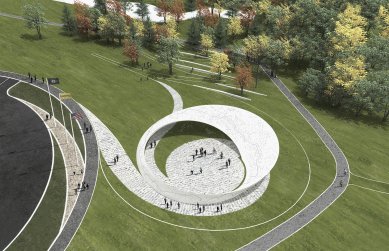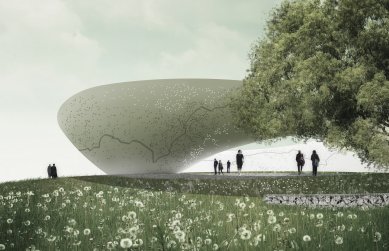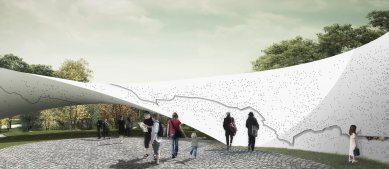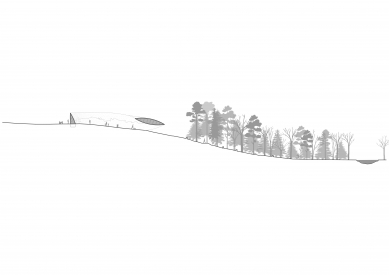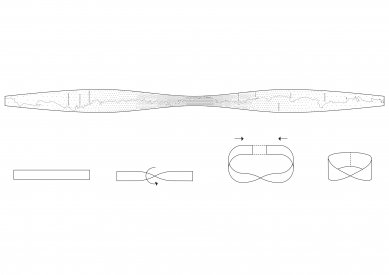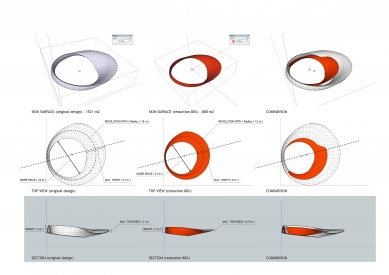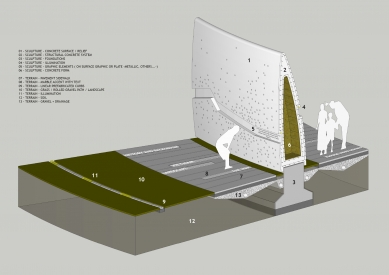
Memorial Tri Ân

Competition Assignment
A group of residents led by Mr. Yung Nguyen, an immigrant from Vietnam, came up with the idea of creating a Thanksgiving memorial in the city of Louisville, Kentucky. They wanted to create a special place to honor the vast number of American and South Vietnamese armed forces soldiers who lost their lives during the Vietnam War. The civil association led by Mr. Nguyen established a foundation tasked with developing the concept and securing funding from private sources for the realization of this memorial. The foundation is named "Tri Ân," which means deep gratitude in Vietnamese.
The foundation acquired a sloped plot of land in the existing veterans' park in Jeffersontown, a suburb of Louisville, USA. Because they wanted a memorial that would be as inspiring and unique as possible, they decided to sponsor a public international architectural competition to help find the most imaginative proposals. The foundation plans to finance and build the Tri Ân memorial according to the winning design. The competition featured 129 projects from 28 countries, with 3 finalists selected in the first round, including CMC ARCHITECTS.
The main purpose of the proposed memorial is to pay tribute and express deep gratitude to the millions of Americans and Vietnamese who fought side by side to stop communist aggression and bring freedom to the people of South Vietnam. For many Vietnamese who fled the country and escaped communist persecution, it is important to make sense of this difficult struggle, to honor those who helped them during and after the war. They believe it is essential to acknowledge the combined efforts of members of the American, South Vietnamese, and other allied forces and to celebrate the bond that was formed among the soldiers from these countries fighting against a common enemy.
It is crucial to recognize the numerous humanitarian efforts and actions carried out by the U.S. military and many Americans who did much more than their duty to help the people of South Vietnam. It is important and right to ceremoniously express gratitude to all who served and sacrificed, and to remember all who fought and died in the war.
CMC ARCHITECTS Design Concept (1st Round Finalist)
The strength of our design lies in the simplicity of the round 'embracing' form symbolizing the connection of people and cultures in a vast human effort and sacrifice. The proposed shape represents a transformed reality, a sense of continuity, and the infinite repetition inherent in every human conflict. It is both a celebration of memory and a gentle gesture of gratitude.
Every memorial needs a way for people to approach it gradually; it needs a symbolic path that allows visitors to mentally and emotionally detach from everyday life and begin to perceive the meaning of the act of honoring memory. The path at the Tri Ân memorial leads visitors around the building toward a contemplative core, to its heart and soul, and ends as a small pathway in the woods.
Visitors can read engraved information along the path and on the wall and reflect on three proposed themes: Background and History, The War with the North, and The People Who Fought for Freedom.
The surface of the memorial features a curve representing the coastline of Vietnam, depicting its history and individual events. The surface of the Tri Ân memorial consists of 4,500,000 marks or points, representing the vast number of people involved in this conflict. These points are embossed, resembling the losses of lives, allowing visitors to literally touch the memories of family members, friends, and loved ones who became victims of this incredible struggle.
The visitor experiences 4 moments:
A group of residents led by Mr. Yung Nguyen, an immigrant from Vietnam, came up with the idea of creating a Thanksgiving memorial in the city of Louisville, Kentucky. They wanted to create a special place to honor the vast number of American and South Vietnamese armed forces soldiers who lost their lives during the Vietnam War. The civil association led by Mr. Nguyen established a foundation tasked with developing the concept and securing funding from private sources for the realization of this memorial. The foundation is named "Tri Ân," which means deep gratitude in Vietnamese.
The foundation acquired a sloped plot of land in the existing veterans' park in Jeffersontown, a suburb of Louisville, USA. Because they wanted a memorial that would be as inspiring and unique as possible, they decided to sponsor a public international architectural competition to help find the most imaginative proposals. The foundation plans to finance and build the Tri Ân memorial according to the winning design. The competition featured 129 projects from 28 countries, with 3 finalists selected in the first round, including CMC ARCHITECTS.
The main purpose of the proposed memorial is to pay tribute and express deep gratitude to the millions of Americans and Vietnamese who fought side by side to stop communist aggression and bring freedom to the people of South Vietnam. For many Vietnamese who fled the country and escaped communist persecution, it is important to make sense of this difficult struggle, to honor those who helped them during and after the war. They believe it is essential to acknowledge the combined efforts of members of the American, South Vietnamese, and other allied forces and to celebrate the bond that was formed among the soldiers from these countries fighting against a common enemy.
It is crucial to recognize the numerous humanitarian efforts and actions carried out by the U.S. military and many Americans who did much more than their duty to help the people of South Vietnam. It is important and right to ceremoniously express gratitude to all who served and sacrificed, and to remember all who fought and died in the war.
CMC ARCHITECTS Design Concept (1st Round Finalist)
The strength of our design lies in the simplicity of the round 'embracing' form symbolizing the connection of people and cultures in a vast human effort and sacrifice. The proposed shape represents a transformed reality, a sense of continuity, and the infinite repetition inherent in every human conflict. It is both a celebration of memory and a gentle gesture of gratitude.
Every memorial needs a way for people to approach it gradually; it needs a symbolic path that allows visitors to mentally and emotionally detach from everyday life and begin to perceive the meaning of the act of honoring memory. The path at the Tri Ân memorial leads visitors around the building toward a contemplative core, to its heart and soul, and ends as a small pathway in the woods.
Visitors can read engraved information along the path and on the wall and reflect on three proposed themes: Background and History, The War with the North, and The People Who Fought for Freedom.
The surface of the memorial features a curve representing the coastline of Vietnam, depicting its history and individual events. The surface of the Tri Ân memorial consists of 4,500,000 marks or points, representing the vast number of people involved in this conflict. These points are embossed, resembling the losses of lives, allowing visitors to literally touch the memories of family members, friends, and loved ones who became victims of this incredible struggle.
The visitor experiences 4 moments:
- After the first few meters, they arrive at a wall that introduces them to the causes of the conflict;
- They pass through a threshold where the wall 'drops'; here, explanatory information about the war is provided;
- Upon entering the core of open space, they are reminded of those who fought in the war, and visitors can bow to them and express their respect and gratitude;
- On the return journey through the woods, visitors can reconcile their feelings before returning to everyday life.
The English translation is powered by AI tool. Switch to Czech to view the original text source.
0 comments
add comment


